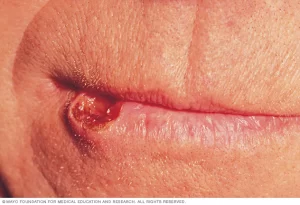 Includes malignant neoplasms of the vermillion border, commissure and labial mucosa, but excludes cancers originating on the skin of the lip.
Includes malignant neoplasms of the vermillion border, commissure and labial mucosa, but excludes cancers originating on the skin of the lip.
Predominantly squamous cell cancer.
Incidence in 2003-2007 0.7/100,000 per year.
Incidence in men, 1.2, is 4 times that in women, 0.3/100,000/yr.
Decreased incidence in women due to fewer women engaged in outdoor work, the use of lipstick and other lip coverings.
Incidence 8 times higher in whites compared to blacks.
A type of oral cancer, with sun, alcohol, tobacco, the human papilloma virus (HPV), male gender, and age over 40 as common risk factors.
Of the approximately 26,000 new oral cancers that are estimated to occur yearly in the United States, 10% to 15% are lip cancer (ACS).
Early lip cancers may have no symptoms, and the most common finding is a sore on the lip that will not heal.
Most lip cancers develop on the lower lip and are squamous cell cancers.
When diagnosed early, lip cancer has an excellent prognosis.
Potentially cured by either surgery or radiation therapy.
Later stages may also be treated with surgery or radiation or a combination of the two.
Chemotherapy and targeted therapies may also be used, particularly for more advanced disease.
Common lip cancer symptoms include:Bleeding, discoloration of the lip, lymphadenopathy, sores, pain, swelling of the lip.
Usually detected early and results in regional metastases occurring in only 5% to 7% of cases and distant metastases in only 0.5-2% of cases.
Darker pigmentation is protective.
The more frequent occurrence in the lower lip corresponds with the main known risk factor, prolonged sun exposure.
Pipe smoking is only infrequently associated as a risk factor, and cigarette smoking has been inconclusive in its relationship, but is suspected.
Drugs associated with increased risk include hydrochlorothiazide, nifedipine, and nicotine.
Increased risk identified in individuals receiving 3 or more prescriptions of photosensitizers diuretic hydrchlorothiazide and calcium channel blocker nifedipine (Frieman GD et al).
